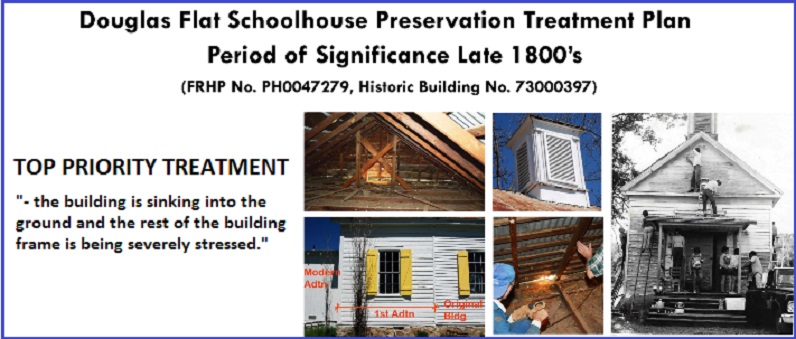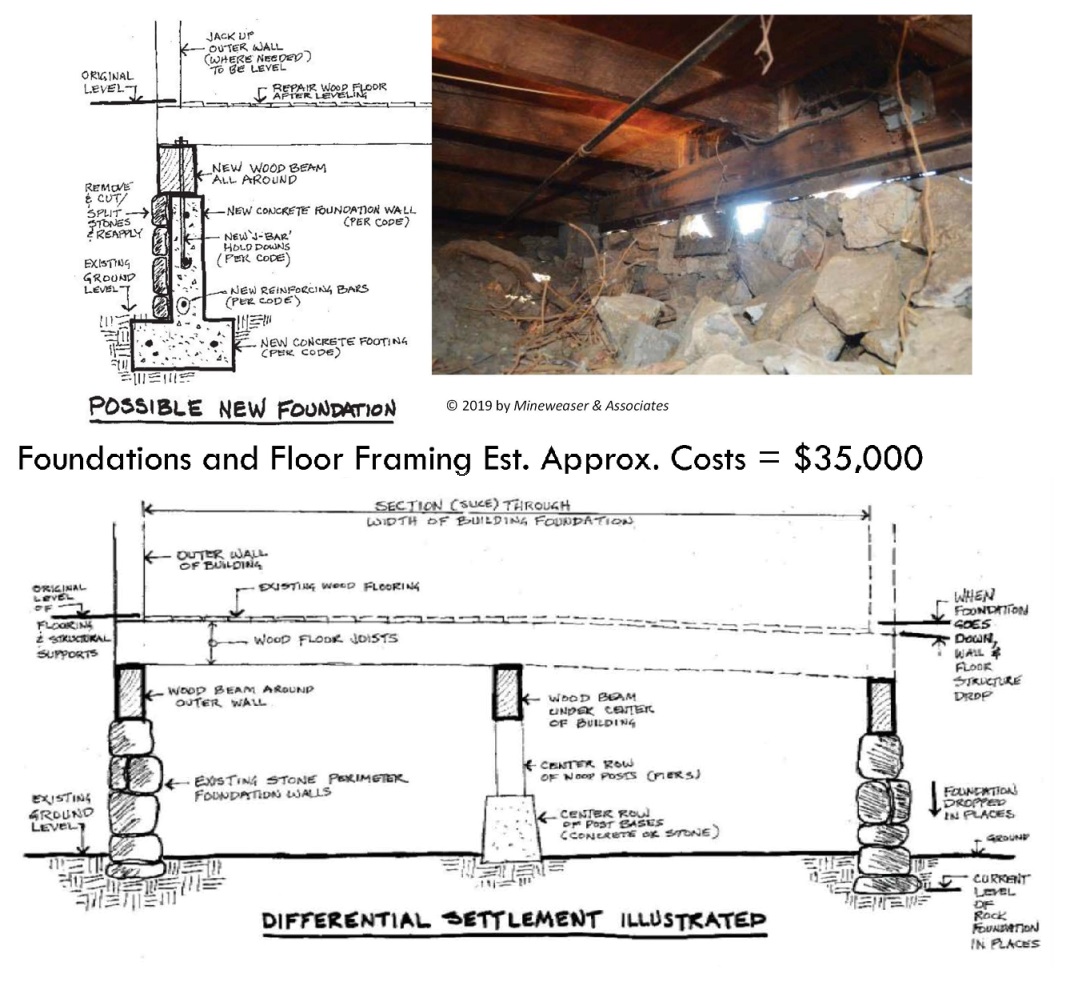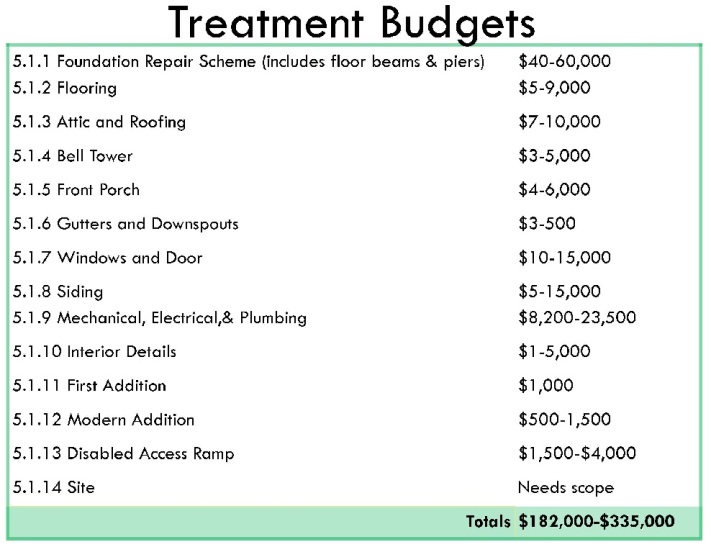You may send donations to DFCC, PO Box 73, Douglas Flat CA 95229
Thanks!
OUR MISSION is to keep the 170-year-old building's doors open well into the future. Major structural improvements are necessary. And other renovations are planned to restore the building to its original appearance. Also landscaping improvements would make the building more desirable for rentals, such as weddings, art classes and wine tasting events.
We are working to revamp this page to make electronic donations easier.




For rental information and other questions contact John Kramer. johnhkramer@gmail.com
Douglas Flat Schoolhouse Preservation Treatment Plan.
To encourage further research and discussion as to what's best for the future of the schoolhouse these excerpts were grabbed from the PDF file to provide a quick look at some of the most relevant aspects of the report from the experts at the preservation of similar historical buildings.
...The Period-of-Significance (POS) for the Douglas Flat Schoolhouse is 1856 to 1908, that period when the features of its Greek Revival style and its use as a school, community meeting place and church can be most clearly and completely understood by the viewer Under Criterion C/3, the schoolhouse retains the distinctive character defining features of the Vernacular Greek Revival architectural style, popular throughout California and the United States in the 1850s and 1860s, especially in rural communities. The schoolhouse retains its integrity of location, design, setting, materials, workmanship, feeling, and association to a remarkable degree.
...cycles of deterioration and repair roughly paralleled the class size and active use of the school...
This school/church/community building was a public building, to be cared for by a group of people, rather than under private periodic maintenance. The photographic evidence indicates that rather than periodic maintenance, as would likely occur with a private owner, the schoolhouse was allowed to deteriorate in repeated cycles, then every few decades with a flurry of activity the community would band together and make repairs and sometimes alterations. These had to last until the next wave of maintenance effort to make the building whole again.
...The setting should be relatively free of modern day intrusions. A property that is clearly visible and interpretable should convey an association or connectedness with historic patterns, persons, designs, or technologies.
[The following excerpts were pasted in here in order as they appear in the report. No outside editorializing is included. The schoolhouse restorations are group decisions involving a lot of people donating a lot of time and money.]
...although the front porch has existed for decades, this report concludes that it is not a character-defining feature of the building. In fact, it obscures one of the major distinctive features displaying this style and this HSR recommends its removal...
"...historic fabric or significance and to ensure the preservation of the historic character of the resource."
“Restoration is undertaken to depict a property at a particular period of time in its history, while removing evidence of other periods.”
RESTORATION is therefore the most appropriate treatment option for this building.
(San Andreas Independent of August 21, 1858).
A Calico Ball was held August 12 to benefit the Douglas Flat School. Dancing from nine to midnight when ice cream, prepared by Mrs. Proper, was brought in. Dancing then continued until supper was served, and then until ‘broad daylight.’ Ladies of the committee were Mesdames Proper, Gunn, Ginter, Henly, and Johns. Over $200 was raised.
...cycles of deterioration and repair roughly paralleled the class size and active use of the school...
1870 with a full width addition 16ft long increasing the size of this one-room schoolhouse to 20ft x 40ft...
...Between 1909 and 1910, a small vernacular Victorian hip-roofed porch was added to the primary façade, altering its Classical style...
...1860 a small, square belfry or bell tower (or in this case more correctly a “Bell Cupola”)...The original wood shingles remain underneath...
Frame pinnacles once decorated each upper corner of the tower, separated with narrow pediments (Elliott 1885:34, Calaveras County Historical Society 1986:39, (Views 1-8b), but were no longer extant by the 1950s (View 10). We refer to this decoration at the top as cresting and it is similar, albeit simpler, to that used on the Murphy’s School bell tower and front porch (View 5.) To better comply with Restoration Standard #’s 5, 6 & 7 of the SIS (Appendix P.2.1), this character-defining feature should be reconstructed, complete with all trim, using photographic evidence and full-dimension lumber...
This porch is a later addition – outside the POS. It was built in a very expedient fashion, does not fit the design of the rest of the building, and completely obscures the most important, character defining feature of the building – the Greek Revival style front door, transom window, and door trim. Some alterations can obtain historic significance in their own right and even though they may be outside the POS, they should remain...
,,,In order to comply with Restoration Standard #’s 2 & 4 of the SIS (Appendix P.2.1), the porch should be documented then removed and the front door and trim restored.
Rafter tails are fully boxed with simplified, classical trim including a simple frieze board. Over time some of these decorative trim boards have been replaced with even simpler flat boards, obscuring some of the detailing. The primary southeast façade features a triangular pediment with wide trim, above a central door. This pediment trim is quite deteriorated and should be restored...By the mid-1950s, the wood shingles and much of the skipsheathing was removed...
...Some of the original glass is extant, but many panes were shot out in 1975 and have been replaced with modern glass.
...The trim was removed on the interior side and the glass was covered with T&G bead-board of a later style than the rest.
The entry door/doors have been replaced several times: in the 1920s with double frame doors of diagonal boards, in the 1950s by double doors, each with one recessed panel and one light, and by 1971 with one wide frame door with five cross panels...
To better comply with Standard #’s 5, 6 & 7 of the SIS, the modern shutters should be documented and removed, then this character-defining feature should be reconstructed using photographic evidence and fulldimension lumber...
In the 1850s flooring was usually thick, 12” wide rough pine planks. This was attached directly to the joists below without an But since a lot of dirt was tracked in, these probably did not last very long. In 1870, during the construction of the addition, all the original flooring was removed and replaced with narrow (about 3 ½” w), smooth finished, T&G, Doug Fir...
Florescent lights and new electric wiring replacing the knob-and-tube were installed during the 1971 work...
A modern galvanized pipe flagpole is located west of the school. It likely dates from the 1971 work...
The relationship of the overall property to its neighbors and of the neighbors to the school has changed significantly and it does not have integrity...
This school/church/community building was a public building, to be cared for by a group of people, rather than under private periodic maintenance. The photographic evidence indicates that rather than periodic maintenance, as would likely occur with a private owner, the schoolhouse was allowed to deteriorate in repeated cycles, then every few decades with a flurry of activity the community would band together and make repairs and sometimes alterations. These had to last until the next wave of maintenance effort to make the building whole again.
...The setting should be relatively free of modern day intrusions. A property that is clearly visible and interpretable should convey an association or connectedness with historic patterns, persons, designs, or technologies.
...The Period-of-Significance (POS) for the Douglas Flat Schoolhouse is 1856 to 1908, that period when the features of its Greek Revival style and its use as a school, community meeting place and church can be most clearly and completely understood by the viewer Under Criterion C/3, the schoolhouse retains the distinctive character defining features of the Vernacular Greek Revival architectural style, popular throughout California and the United States in the 1850s and 1860s, especially in rural communities. The schoolhouse retains its integrity of location, design, setting, materials, workmanship, feeling, and association to a remarkable degree.
Because of this evaluation, it has been determined that the front porch feature poses a negative impact on the historic resource and should be documented and then removed. Upon its removal the front entry unit, including the original style doors, the transom glazing and the complete Greek Revival trim work should be restored to its original appearance.
The Belfry cupola should be rebuilt using correct sizes of lumber and trim from 1860. The unusual cresting trim at its roof should be recreated.
Shutters: It is further determined that the unusual Bermuda style exterior window shutters be reconstructed and that the roof access ladder near the exterior front be recreated.
The negative impact of the front porch can be mitigated by its documentation and removal, and then restoration of the complete front entry door and trim – the most important character-defining feature of the building – can move forward...unusual Bermuda shutters mitigates this loss. The wooden access ladder, an unusual but useful feature at the front corner of the exterior should be reconstructed. Of course, it should have a security cover, but that is discussed in Part II of this report. In addition, restoring the belfry feature to its full glory mitigates the negative impact on the schoolhouse of the current state of this character-defining feature...
1971 – Building was again in disrepair so community again made some repairs: Painted exterior Installed electric system and florescent strip lights in ceiling Dutch Colonial style shutters replace the Bermuda style that were in poor condition...
The front porch was added in 1909 in a very expedient manner. It covers the transom window and obscures the fine Greek Revival detailing of the trim surrounding the front door. The Historical and Architectural Evaluation (see Part I above) says that this feature, which does not fall within the years of the POS, has a negative impact on the resource and should be removed so that the front door, and its transom with surrounding trim, can be reconstructed. This entire Greek Revival style entry is a character-defining feature of the greatest significance to displaying the style of this building.
If it is to remain it will have to be rebuilt due to deterioration, but it will be a constant maintenance headache.
Keep in mind that there was no gutter on this feature prior to this and that the SIS says we should not create false history.
However, the windows are one of the most historically significant character-defining features of any historic building.
If the front porch is to be removed, then the entire front entry, including the Greek Revival trim, the transom window and a pair of wood panel doors should be reconstructed using the photographs in the Part 1 - Appendix in order to comply with the SIS. The stylistic details of the front door will be unmasked in the historic photos in the Evaluation Report, and should be followed carefully. The rear door enters the nonhistoric addition and only maintenance and weatherstripping improvement is required there. The interior door from the main room into the addition is also not historic and on maintenance need be considered. Both meet the SIS.
Part 1 of this HSR report calls for reconstruction of the unusual Bermuda shutters and contains an extensive description of them. Use the historical photographs and use decay resistant wood such as cedar. Custom milling will be needed to obtain material in period appropriate sizes. Or if manufactured shutters are chosen, the size of each individual wood piece should be checked to confirm that it is period-appropriate. Reproduction hardware is available.
Moisture intrusion is the primary cause of most problems and deterioration with wood buildings. The single most effective way to inexpensively maintain the integrity of all the exterior wood pieces of siding and trim is to keep an intact film of paint on the entire building to keep out moisture. This means using high quality paint and doing a thorough prep job.
When the porch was added the transom window over the front door was covered, with a different style wood paneling (right). The window may still be there. Part I of this report says that the original door should reconstructed and the transom exposed and restored.
Perhaps some thought could be given to other site improvements that might make the building more attractive as a rental, while still following the SIS for retention and restoration of character-defining site features dating from the Period of-Significance.
...Historic photographs should be studied for clues to what the site looked like during the Period-of Significance. For the present it is clear that the flag pole and the outhouse remains are important features to keep. However, if the outhouse is currently in its original location, consideration might be given to relocating it elsewhere on the site, to avoid ‘bottle hunters’ from plundering its historic artifacts. Of course there are pits under earlier outhouses that probably remain in other areas of the site (study the old photographs for clues.) And, while there is no requirement to do so, at some future point you might want to use GPR to obtain a map of potentially historic artifacts just below the surface of your site. Then, over a period of time, and ONLY under the advice and supervision of an archaeologist, you could retrieve some of these to display in order to better tell the story of what life was like back then and how the building fit into the life of the community. However, DO NOT DISTURB these items without an archaeologists help. They will be doing their work under the rules of the SIS and those of the OHP.
A small frame garage, with doublehinged doors, is located northwest of the school. It has a moderately pitched front gable roof, horizontal board siding on the front elevation and vertical board and batten siding on the other elevations.
| |